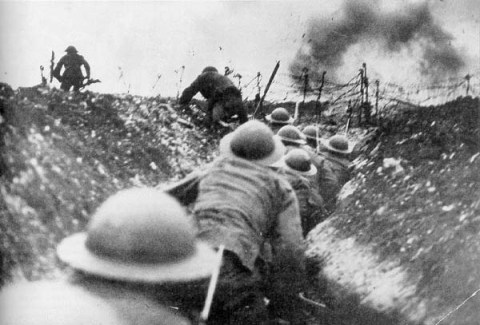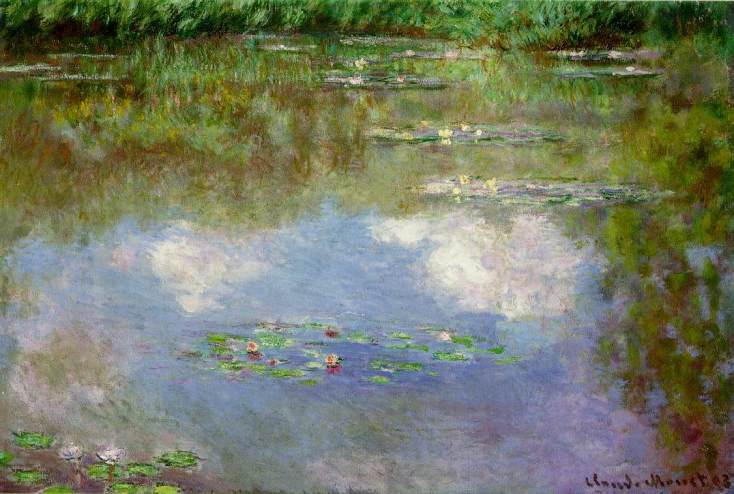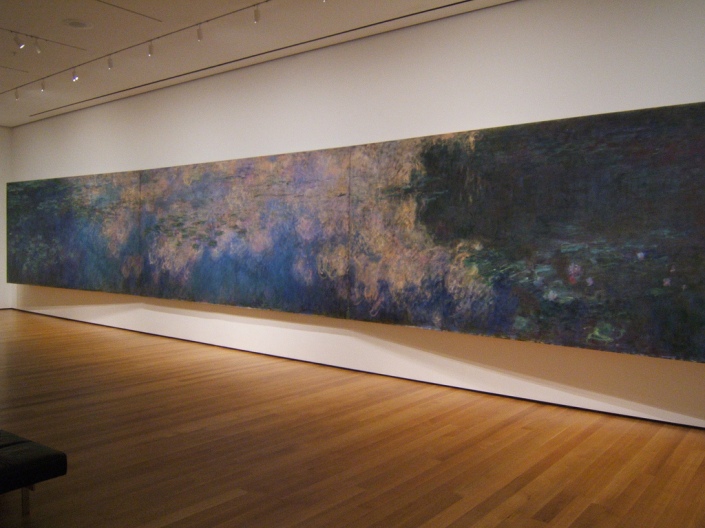“Let Us Believe in Art”
March 8, 2014 § 3 Comments
Is being an artist today a selfish pursuit? If a painter does not address the political, environmental, or social ills of the age through painting is he or she just a naive Peter Pan, an escapist, or a wishful thinker painting pretty pictures while the world goes up in flames? What possible value does art have in a world so beset by problems? Every art student asks these questions at some point. Shouldn’t I be doing something to help the world? In the face of the unprecedented human misery of our time shouldn’t we, as artists, forget about our selfish visions and ideals about beauty and serve humanity?
In 1915 World War I was raging across Europe. Claude Monet, then 75 years old, wrote the following in a letter to Raymond Keochlin, an art collector:
“Yesterday I was able to resume work, which is the only way to avoid thinking of these troubled times. All the same I sometimes feel ashamed that I am devoting myself to artistic pursuits while so many of our people are suffering and dying for us. It’s true that fretting never did any good. So I’m pursuing my idea of the Grande Decoration. It’s a very big undertaking, particularly for someone my age, but I have every hope of succeeding if my health doesn’t give out. As you guessed it, it’s the project that I’ve had in mind for some time now: water, water-lillies, plants, spread over a huge surface. Let’s hope that event’s will take a turn for the better. I’d be glad to see you and show you the beginnings of this work. Friendly greetings, Claude Monet”
Monet’s Water Lillies at the Museum of Modern Art, NYC.
Another 19th century artist, the American painter George Inness, had some things to say about the higher functions of art in a society. He said, “Let us believe in Art, not as something to gratify curiosity or suit commercial ends, but something to be loved and cherished because it is the Handmaid of the Spiritual Life of the age… The true use of art is, first, to cultivate the artist’s own spiritual nature, and, second, to enter as a factor in general civilization. And the increase of these effects depends on the purity of the artist’s motive in the pursuit of art. Every artist who, without reference to external circumstances, aims truly to represent the ideas and emotions which come to him when he is in the presence of nature is in process of his own spiritual development and is a benefactor of his race.”
That’s all fine and good for the 19th century you may say. But what about today? For anyone, seasoned artists or aspiring students, questioning art as a worthy vocation for assisting an embattled planet, painter Alan Feltus offers these thoughts:
“I think art wants to be something people can turn to for a kind of meaning in their lives, or for a calm place within the turbulence of our modern world. Art doesn’t have to explain our situation within the complexity of a chaotic and unstable society. Art can become social commentary, but it can also serve a much needed purpose providing a place of refuge wherein one can find a reason, or justification, for all the battling we have to do, mentally or physically, most of every day of our lives. After all, we love the art of the past for itself, generally being ignorant of the context, the politics, let’s say, of the time and place in which it was made. We hold onto our favorite pieces in our favorite museums or churches, in our books, and we love to be moved by the beauty of something newly found. Art should have that kind of place in our lives. Art should be about transcendence. It should not merely reflect our surroundings like a mirror, adding to the clutter, but become something more wonderful, more meaningful than that. It wants to be remembered and returned to over and over again. Good art feeds us. It is so important.” (From a letter to Arden Eliopoulos, Assisi, May 2, 2001. Courtesy of Alan Feltus’ website.)
Contemporary Figure Paintings
March 22, 2013 § Leave a comment
Every decade or so an article appears in the press proclaiming the return of the figure in art, implying that it somehow “went away.” In fact, the figure as a subject for painting never went away, and never will until the human race itself disappears. In a symposium on drawing several years ago at Randolph-Macon Womans College (now Randolph College) in Lynchburg, Virginia, I heard Janet Fish say, “Isms come and isms go, and the realists just keep painting.” (Or something to that effect.) Her statement could, I think, be applied accurately to the state of figure painting. Whatever the current obsession of the so-called art world, artists just keep painting the figure. Below is an album of some of the most compelling figure artists working today.
 Phil Geiger, figure study, oil on panel, 14″ x 10.” Collection of Frank Hobbs
Phil Geiger, figure study, oil on panel, 14″ x 10.” Collection of Frank Hobbs
Alan Feltus: Words on Art
April 1, 2012 § 6 Comments
I first met Alan Feltus when I was a graduate student at at American University where he taught until he and his wife, painter Lani Irwin, decided to move to Italy, near Assisi, to live, work, and raise their children. I often sat in on Alan’s figure drawing classes, absorbing his deep love of painting, particularly the work of the Italian masters. My strongest memories are of Alan sitting on the model stand before the model took the stage, surrounded by art books which he would open to certain pictures and discuss with the class, like a rabbi giving an exegesis on sacred texts.
Here are some of his thoughts about art, which you can read in greater detail, along with essays written about his work by others, from his website.
“February 2003, Assisi”
These paintings are about many things and at the same time about nothing more than painting itself. They don’t have narrative content; they don’t tell stories. What the figures communicate is not knowable, not to me and therefore not to the viewer. Or perhaps I should say what is communicated is open to interpretation and as such there are endless meanings. Endless possible readings. They are quiet images with unspoken, and elusive meanings. They are abstract in the same way instrumental music is abstract. They convey something. They create a certain mood. We feel something when we slow down and focus on what a painting says. They are readable the way the world is readable to us. We need not ask how we should understand everything we observe.
I paint without models. I draw upon many kinds of sources, but largely those painters, from ancient to modern, whose works have taught me most throughout my career. They tend to be the painters who structure their paintings tightly.They are masters of much more than that but, it seems, always masters of composition. More than not, they also painted from within. Or perhaps they, like myself, are observering art and nature all the time while not in the studio, and then while painting rely on what has been internalized. Each of us will have a unique compilation of remembered sensations and it is how this material shapes our work that will distinguish my paintings from those of the next painter. We really don’t have all that much control over what we produce when we work from within.
What unfolds on the canvas evolves slowly. My paintings take weeks or months to complete. They have many layers of changes and then more layers of refinement before every element feels right in relation to every other. Form gradually defines itself in light, and light and color begin to work.
(From a letter to Arden Eliopoulos. Assisi, May 2, 2001).
I think art wants to be something people can turn to for a kind of meaning in their lives, or for a calm place within the turbulance of our modern world. Art doesn’t have to explain our situation within the complexity of a chaotic and unstable society. Art can become social commentary, but it can also serve a much needed purpose providing a place of refuge wherein one can find a reason, or justification, for all the battling we have to do, mentally or physically, most of every day of our lives. After all, we love the art of the past for itself, generally being ignorant of the context, the politics, let’s say, of the time and place in which it was made. We hold onto our favorite pieces in our favorite museums or churches, in our books, and we love to be moved by the beauty of something newly found. Art should have that kind of place in our lives. Art should be about transcendence. It should not merely reflect our surroundings like a mirror, adding to the clutter, but become something more wonderful, more meaningful than that. It wants to be remembered and returned to over and over again. Good art feeds us. It is so important.
(From a letter to Joseph Jennings, July 27, 2000, Assisi)
Yesterday I struggled more with the painting on my easel. There have been things about the space that hadn’t been working. Maybe it made some advances yesterday. Painting can move very slowly for me. Lani’s as well. But painting is the one thing I seem to have endless patience with. I know it wants to move slowly at times. There are so many days when nothing is resolved yet those days are necessary in order to progress beyond whatever it is that holds a painting back. The painting needs to reflect an inner self. It results from a meditative state, it seems. And those sleepy days at the easel when nothing seems to move ahead are essential. You understand all that quite instinctively, it seems to me.



